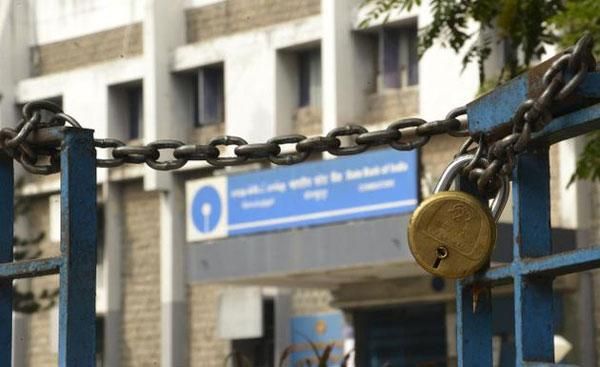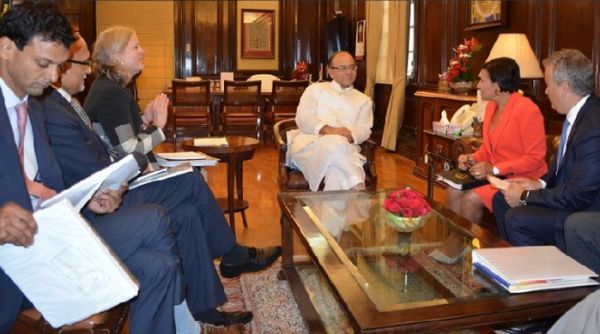
by admin | May 25, 2021 | Banking, Corporate, Corporate finance, Economy, Markets, News
 Chennai : The Centre’s Rs 2.11 trillion recapitalisation for public sector banks though a welcome move, the focus should not be lost on recovering the loans by allowing the banks to take a “haircut” (a euphemism for loan write offs), said a top leader of All India Bank Employees’ Association (Aibea).
Chennai : The Centre’s Rs 2.11 trillion recapitalisation for public sector banks though a welcome move, the focus should not be lost on recovering the loans by allowing the banks to take a “haircut” (a euphemism for loan write offs), said a top leader of All India Bank Employees’ Association (Aibea).
“The recapitalisations announced by the central government on Tuesday is welcome. The government should take care that such loan profligacy to corporates is not repeated at the cost of tax payers.
“It is time the government starts fixing responsibility for bad decisions taken in the guise of commercial decisions,” C.H. Venkatachalam, General Secretary, Aibea told IANS on Thursday.
He also said it was high time the top government bank executives –Chairmen, Managing Directors, Executive Directors — were also brought under service/conduct/disciplinary rules.
According to Venkatachalam, lack of capital and the non-recovery of the corporate loans were afflicting the banks.
He said the non-performing loans (NPL) of the government banks is over Rs 800,000 crore and focus should be on recovering the same than going in for write-offs on the back of fresh funds infusion announced by the government.
Referring to Finance Minister Arun Jaitley’s comments that steps would be taken so that further NPL was not created Venkatachalam said: “It is time to fix accountability on those sanctioning loans.
“The credit committee and the Board of Directors should be made accountable for their decisions. They should not be allowed to escape under the guise of commercial decision for sanctioning loans without prudence.”
According to him, bad loans in the banks, particularly, the big ticket accounts were a potential zone for corruption and there was no defined regulation to take action on top executives like Chairmen, Managing Directors and Executive Directors of government-owned banks.
“The top officials are not government by common Officers Conduct Rules,” Venkatachalam said.
“There should be separate conduct rules for the top executives as they are dealing with tax payers monies,” Venkatachalam said.
Terming the current procedure to fix responsibility on top executives of government banks as cumbersome, Venkatachalam said: “A transparent and effective rule is to be evolved to deal with the complaints against these officials.”
—IANS

by admin | May 25, 2021 | Banking, Commodity Market, Corporate, Corporate finance, Corporate Governance, Economy, Finance, Investing, Markets, News, Politics
 New Delhi : In a stimulus package aimed to boost flagging economic growth, create jobs and increase credit flow, the Union Cabinet on Tuesday approved a Rs 2.11 lakh crore recapitalisation plan for state-run banks and massive road infrastructure investment of nearly Rs 7 lakh crore over five years.
New Delhi : In a stimulus package aimed to boost flagging economic growth, create jobs and increase credit flow, the Union Cabinet on Tuesday approved a Rs 2.11 lakh crore recapitalisation plan for state-run banks and massive road infrastructure investment of nearly Rs 7 lakh crore over five years.
Indian industry warmly welcomed the steps.
Of the support to banks, Rs 1.35 lakh crore will be raised through recapitalisation bonds and the remaining sum through budgetary support and market borrowings, Financial Services Secretary Rajiv Kumar told the media in the presence of Finance Minister Arun Jaitley and a battery of Ministry Secretaries.
Under the road connectivity programme, the government will construct 84,000-km highways in five years. Of this, the Bharatmala project component will involve an outlay of Rs 5.35 lakh crore and generate 14.2 crore man-days of work.
Its funding will be raised as debt from the market (Rs 2.09 lakh crore), private investments through PPP (Rs 1.06 lakh crore) and from accruals to the central road fund and toll collections (Rs 2.19 lakh crore).
Jaitley said the economic blueprint to revive growth being presented follows extensive recent discussions on the state of the Indian economy.
“You will recall the press conference last time, where I mentioned we will respond appropriately to the situation as it develops,” he said.
“We have conducted an analysis within the Ministry and held detailed consultations with the Prime Minister on the state of the economy. We have decided on the steps needed to sustain the growth momentum,” the Finance Minister said.
“The unprecedented recapitalisation and the initiatives announced today (Tuesday) are expected to have a noticeable impact in the near term, contributing to accelerated economic activity, employment, and growth of the economy,” he added.
The public sector banks’ recapitalisation comes amid increase of their non-performing assets (NPAs), or bad loans, to 82 per cent of their stressed assets, Kumar said.
“The NPAs of government banks have increased to Rs 4.55 lakh crore between 2015 and 2017,” he said.
“Of this, 12 cases, since referred to the NCLT (National Company Law Tribunal), account for Rs 1.75 lakh crore, or 25 per cent of all NPAs,” he added.
Pointing out that the accumulated NPA figures reflect the result of “aggressive lending” in the past, Jaitley said the government’s move to fund banks comes at a time when private sector investment has dwindled.
Chief Economic Advisor Arvind Subranmanian, who was also present at the briefing, clarified that the recapitalisation bonds would count as debt, while their exact nature would be made available in due course.
The government, however, denied that this support to banks would affect fiscal consolidation.
The Finance Minister said the banks would get Rs 18,000 crore under the Indradhanush plan.
Under the Indradhanush roadmap introduced in 2015, the government had announced infusion of Rs 70,000 crore in state-run banks over four years to meet their capital requirement in line with global banking risk norms known as Basel-III.
This stimulus package comes after data from various sources showed India’s GDP growth flagging under the twin impact of demonetisation and Goods and Services Tax.
Commenting on the development, State Bank of India Chairman Rajnish Kumar said in a statement: “This milestone announcement on recapitalising banks in one go is a bold and courageous move and the need of the hour.”
“It will generate balance in overall demand and supply by bringing more investments in sectors like infrastructure. These funds will also help in efficiently managing risk and credit capital related requirements of the banks.”
The Confederation of Indian Industry (CII) welcomed the move, saying it will kick-start the credit cycle and facilitate private investments.
“The Cabinet decision to address a vital issue is very timely and welcome. We are especially pleased with the announcement of recapitalisation bonds, which CII had recommended strongly, among other measures,” said Chandrajit Banerjee, Director General, CII.
Industry chamber Ficci said it hoped the Reserve Bank of India will also pro-actively seek to boost investment and consumer demand through an easing of the repo rate.
The decision to invest in PSU (public sector undertaking) bank recapitalisation should result in increased lending, especially to the MSME (micro small and medium enterprises) sector,” said Pankaj Patel, President, Ficci.
The day’s announcement of recapitalisation along with a booster dose of Rs 14 lakh crore expenditure will prove to be a mega turnaround point for the Indian economy which was tackling issues out of GST and demonetisation, said D.S. Rawat, Secretary General, Assocham.
“These measures would surely set the stage for revival of private sector investment,” he said.
—IANS

by admin | May 25, 2021 | Banking, Corporate, Corporate finance, Corporate Governance, News, Politics
 New Delhi : Recapitalisation is a major issue for state-run banks owing to the massive non-performing assets (NPAs), or bad loans, accumulated by them and they are now exploring various sources of raising capital, according to a leading public sector bank (PSB).
New Delhi : Recapitalisation is a major issue for state-run banks owing to the massive non-performing assets (NPAs), or bad loans, accumulated by them and they are now exploring various sources of raising capital, according to a leading public sector bank (PSB).
“Banks’ capitalisation is a major issue for PSBs. We have to make high provisions, also now with the NCLT (National Company Law Tribunal) cases,” UCO Bank Chief Executive R.K. Thakkar told BTVi channel.
The Reserve Bank of India (RBI) has identified the second batch of large accounts which have defaulted in repayment of loans and has advised banks to resolve them.
In June, the RBI had come out with a list of 12 large accounts, which totalled about 25 per cent of the current gross NPAs of the banking system for reference to the NCLT under the Insolvency and Bankruptcy Code (IBC).
“We are trying various source to raise capital… We have requested the government for support, but for the balance beyond the budgetary support we have to go to the market, depending on the appropriate time,” Thakkar said.
He said the UCO Bank’s capital requirement for the current fiscal is to the tune of Rs 3,000 crore and “with the provisioning required for the NCLT cases the requirement may go up to another Rs 500-600 crore.”
The RBI has also advised banks to make higher provisions for the accounts to be referred under the IBC.
This was intended to improve bank provision coverage ratios and to ensure that banks are fully protected against likely losses in the resolution process.
Thakkar said that he expected the first tranche of the government support to arrive to the bank in a month’s time.
He also said that recapitalisation bonds would be one of the possible instruments to explore in the efforts to supplement the government recapitalisation.
The PSBs have accumulated a high ratio of NPAs, going up to 17-18 per cent of their loan portfolio.
The government has committed Rs 70,000 crore for banks’ recapitalisation over five years, of which Rs 10,000 crore remains to be disbursed for the current fiscal.
—IANS

 Chennai : The Centre’s Rs 2.11 trillion recapitalisation for public sector banks though a welcome move, the focus should not be lost on recovering the loans by allowing the banks to take a “haircut” (a euphemism for loan write offs), said a top leader of All India Bank Employees’ Association (Aibea).
Chennai : The Centre’s Rs 2.11 trillion recapitalisation for public sector banks though a welcome move, the focus should not be lost on recovering the loans by allowing the banks to take a “haircut” (a euphemism for loan write offs), said a top leader of All India Bank Employees’ Association (Aibea).
